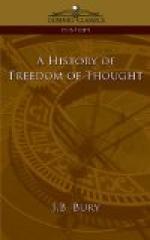The rise of rationalism within the English Church is interesting and illustrates the relations between Church and State.
The pietistic movement known as Evangelicalism, which Wilberforce’s Practical View of Christianity (1797) did much to make popular, introduced the spirit of Methodism
[202] within the Anglican Church, and soon put an end to the delightful type of eighteenth-century divine, who, as Gibbon says, “subscribed with a sigh or a smile” the articles of faith. The rigorous taboo of the Sabbath was revived, the theatre was denounced, the corruption of human nature became the dominant theme, and the Bible more a fetish than ever. The success of this religious “reaction,” as it is called, was aided, though not caused, by the common belief that the French Revolution had been mainly due to infidelity; the Revolution was taken for an object lesson showing the value of religion for keeping the people in order. There was also a religious “reaction” in France itself. But in both cases this means not that free thought was less prevalent, but that the beliefs of the majority were more aggressive and had powerful spokesmen, while the eighteenth-century form of rationalism fell out of fashion. A new form of rationalism, which sought to interpret orthodoxy in such a liberal way as to reconcile it with philosophy, was represented by Coleridge, who was influenced by German philosophers. Coleridge was a supporter of the Church, and he contributed to the foundation of a school of liberal theology which was to make itself felt after the middle of the century.
[203] Newman, the most eminent of the new High Church party, said that he indulged in a liberty of speculation which no Christian could tolerate. The High Church movement which marked the second quarter of the century was as hostile as Evangelicalism to the freedom of religious thought.
The change came after the middle of the century, when the effects of the philosophies of Hegel and Comte, and of foreign Biblical criticism, began to make themselves felt within the English Church. Two remarkable freethinking books appeared at this period which were widely read, F. W. Newman’s Phases of Faith and W. R. Greg’s Creed of Christendom (both in 1850). Newman (brother of Cardinal Newman) entirely broke with Christianity, and in his book he describes the mental process by which he came to abandon the beliefs he had once held. Perhaps the most interesting point he makes is the deficiency of the New Testament teaching as a system of morals. Greg was a Unitarian. He rejected dogma and inspiration, but he regarded himself as a Christian. Sir J. F. Stephen wittily described his position as that of a disciple “who had heard the Sermon on the Mount, whose attention had not been called to the Miracles, and who died before the Resurrection.”
[204]




